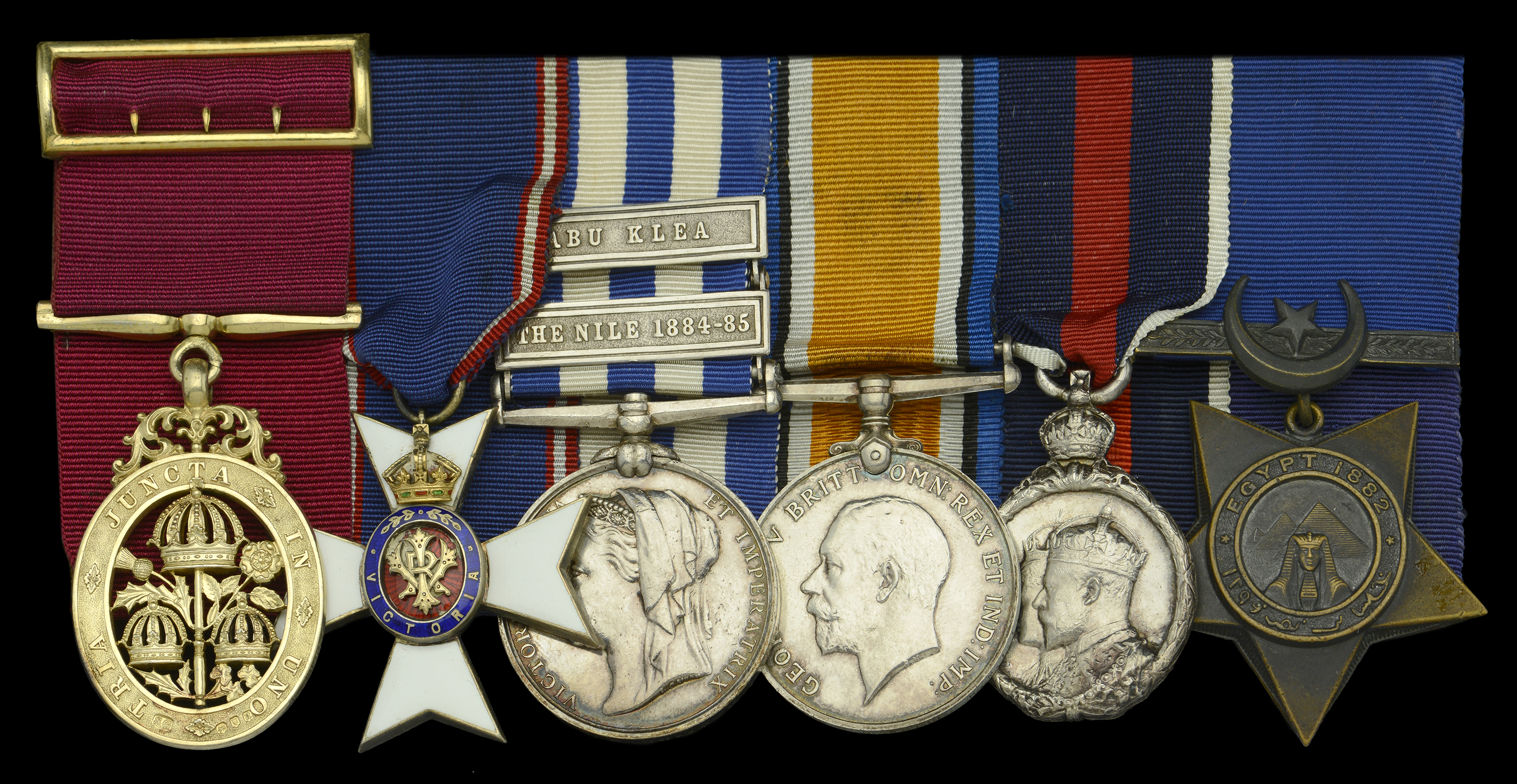The rare Great War C.B., royal visit M.V.O. group of six awarded to Major-General H. S. N. White, Royal Marine Light Infantry, who saw action with the Camel Corps at Abu Klea The Most Honourable Order of the Bath, C.B. (Civil) Companion’s breast badge, silver-gilt, hallmarked London 1916, complete with ribbon buckle; The Royal Victorian Order, M.V.O., Member’s 4th Class breast badge, silver-gilt, gold and enamels, the reverse officially numbered ‘430’; Egypt and Sudan 1882-89, undated reverse, 2 clasps, The Nile 1884-85, Abu Klea (Lieut. H. S. N. White, R.M.L.I.) impressed naming; British War Medal 1914-20 (Brig. Gen. H. S. N. White. R.M.L.I.); Coronation 1902, silver; Khedive’s Star, dated 1882 [note should be 1884-6] mounted court-style for wearing, light contact marks, otherwise good very fine (6) £4,000-£5,000 --- Importation Duty This lot is subject to importation duty of 5% on the hammer price unless exported outside the UK --- --- Provenance: Alan Hall Collection, June 2000. Just four Royal Marine officers received the Egypt & Sudan medal with clasps ‘The Nile 1884-85’ and ‘Abu Klea’. C.B. (Civil) London Gazette 1 January 1917. M.V.O. 4th Class London Gazette 11 March 1906. An award for ceremonial work and Guard of Honour duties during the visit of the Prince and Princess of Wales to India 1905-06. Herbert Southey Neville White was born on 23 July 1862, the son of the Reverend H. S. White, of Tunstead, Norfolk, and was educated at Marlborough. Commissioned as a Lieutenant in the Chatham Division of the Royal Marine Light Infantry in September 1882, he was embarked for ‘special service’ in the flagship H.M.S. Alexandra in May 1884, namely for duties ashore in the Royal Marine Battalion in Egypt and the Sudan. He subsequently participated in the defence of the Sphinx Redoubt at Suakin from 17 June to 24 October 1884 and was one of four Marine officers appointed to the Royal Marine detachment of the Guards Camel Regiment in the advance up the Nile to rescue General Gordon at Khartoum. During that period, he was present at the actions of Abu Klea and Abu Kru (Gubat) and at the reconnaissance in force at Metemmeh, and the attack on the convoy of wounded, and at all other operations in the Bayuda Desert during the advance on the Nile. At Abu Klea and Abu Kru in particular, White and his men were heavily engaged with the Guards Camel Regiment in their defensive squares, their accurate rifle fire undoubtedly contributing to the defeat of the Dervish onslaught. But such was the scale and ferocity of the enemy attack in the former affair that our losses, accrued in just 10 minutes, were 76 killed and 82 wounded. The Mahdists took approximately 1,500 casualties. In The River War, Winston Churchill described the battle at Abu Klea as ‘the most savage and bloody action ever fought in the Sudan by British troops.’ On his return from Egypt, White was posted to the Divisional Headquarters at Chatham. Then, in September 1886, he was embarked in the steam corvette Canada, in which he served with the North America and West Indies Squadron. Having then been appointed to the Naval Intelligence Department at the Admiralty in December 1889, he was promoted to Captain on 1 June 1892. He returned to sea in the battleship Ramillies in the summer of 1895, the flagship of Admiral Sir John Hopkins, K.C.B., Commander in Chief on the Mediterranean Station. He next held a staff appointment in the Chatham Division, during which period he was advanced to Major in October 1899 and received the Coronation 1902 medal for his command of a Guard of Honour to Edward VII. White then returned to sea in the flagship Bulwark on the Mediterranean station, followed by a tour of duty in the battleship Renown in which he commanded the detachment of Royal Marines who, on the occasion of the visit to India in 1905-06 by the Prince and Princess of Wales, were called upon for guard and ceremonial duties. For these services he was awarded the M.V.O. 4th Class. Advanced to Lieutenant-Colonel in November 1907, White returned to the Admiralty as an Assistant Director in the Naval Intelligence Department, prior to being appointed Inspector of Marine Recruiting in October 1910. And on his promotion to Brigadier-General in January 1914, he became Colonel Commandant at the Royal Marine depot at Deal. He remained likewise employed for the duration of the Great War, being awarded the C.B. (Civil) and placed on the Retired List as a Major-General in May 1918. He died in February 1938. Sold with copied record of service and other research.





